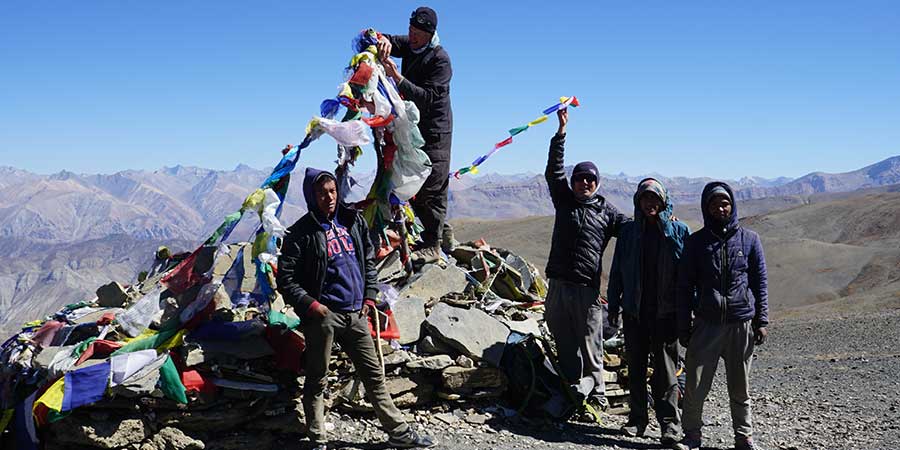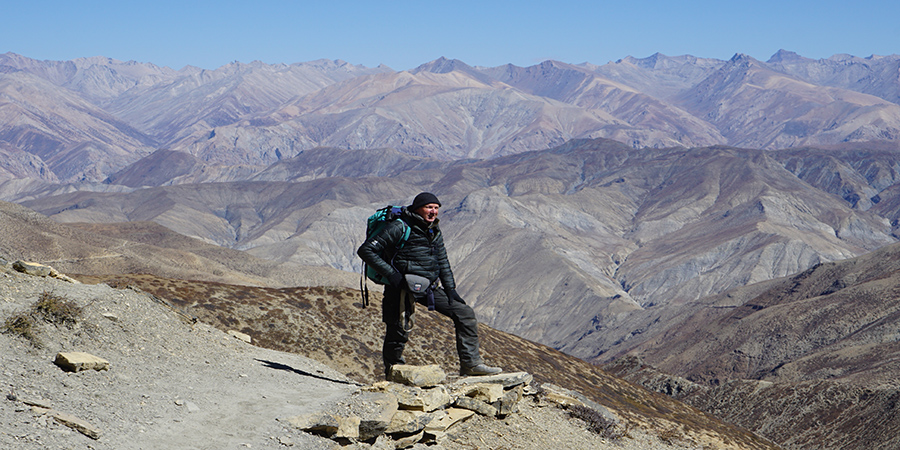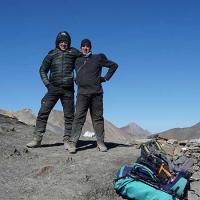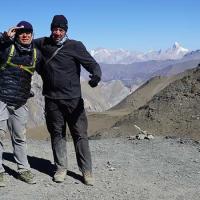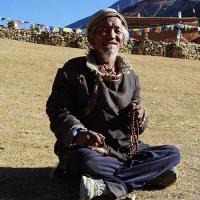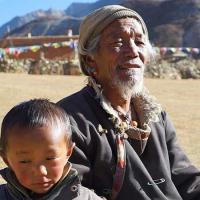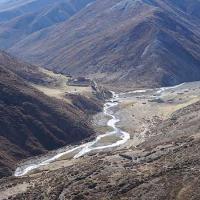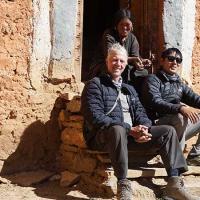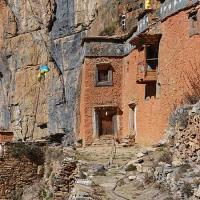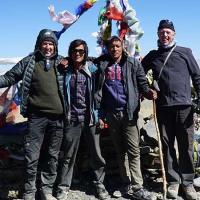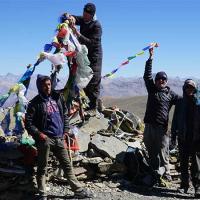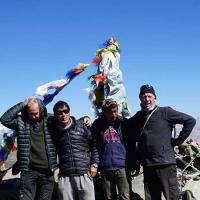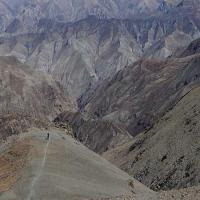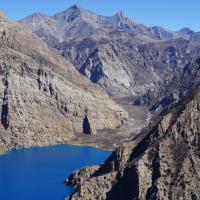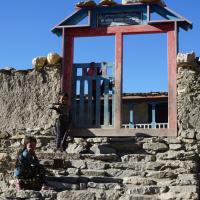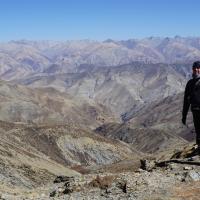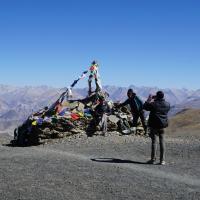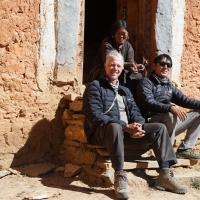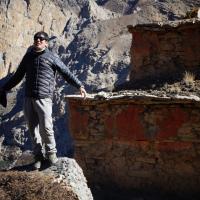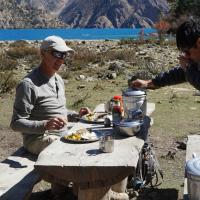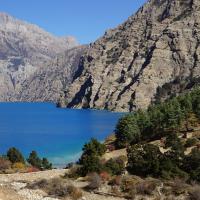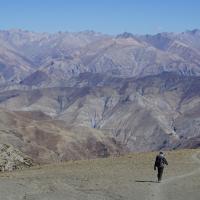

Email Us
contact@destinationhimalayatreks.com
Viber/Whats App 
+977-98510 16814 (Min Gurung)+977-98511 46814 (Tara Rana)
Upper Dolpo Trek
$3999 per Pax
Overview
Once a branched-out part of Tibet, Dolpo is among those extraordinary travel destinations which remain elusive to the eyes of foreign travelers. Unlike any other location within Nepal’s territory, the seemingly exotic-looking Upper Dolpo has a reputation for being a melodramatic region where prehistoric ancient cultural traditions, mysterious canyons, and breathtaking landscapes co-exist together to become a surreal destination for you to get lost in.
Perfect for travelers looking for a strange and beautiful adventure, our Upper Dolpo Trek starts with an amazing journey on a short but mind-blowing flight to Nepalgunj from the bustling capital city of Nepal- Kathmandu. Similarly, there’s another flight scheduled for you the next day which is designated to take you to Juphal. In doing so, you feel an incongruent sensation as you arrive at the entry point of Upper Dolpo. Now, without further ado, you begin trekking from Juphal to Dunai to Chhepka. Hence, by spending the night there, the altitude will have very little effect on your body. On day six, we reach Shey Phoksundo Lake which is also known as the deepest lake in Nepal. You can explore the serene, verdant vicinity of Shey Phoksundo and then follow a trail towards Kang La pass (5,375m). Likewise, we traverse past the settlements of Saldang, Sibu, Jeng La Phedi, and Tokyu Gaon via Jeng La pass (5,150m).
With its overwhelming natural views and awe-inspiring scenery, Upper Dolpo offers an adventure of a lifetime to anyone who wishes to do something out of the ordinary during their holidays in Nepal. Moreover, our Upper Dolpo Trek can be done even during monsoon season as it falls on the rain shadow of the Annapurna mountain range and Mt. Dhaulagiri. So, it is very less problematic to travel here if you have chosen to visit Nepal between June, July, and August. Kindly request you all to view trip videos provided by our client Henk Visser-Jumla to Phoksundo Lake https://youtu.be/PySRplZFCkY and Phoksundo Lake to Jomsom https://youtu.be/afXc470UxYg
- Abundance of green lush meadows, subalpine and alpine forest, picturesque landscape of the Upper Himalayas, views of Dhaulagiri Ranges, and snow-covered mountains
- Extraordinary range of flora and fauna in the Shey Phoksundo National Park, home to snow leopard, blue sheep, mountain musk deer, and more
- The soothing, the turquoise waters of Shey Phoksundo lake- Nepal’s deepest lake and its glorious scenery
- Visit Shey Gompa, Yangze Gompa, and Bon Gompa
- Caravans of yaks, mules, horses, and sheep for transportation
- Exploring pristine Tibetan Buddhist culture, lifestyle, and its monasteries
- Nomadic lifestyle of locals in its raw form despite such scarcity, unique chord of rustic authentic villages
Short Itinerary
Day 01: Kathmandu Arrival and transfer to hotel
Day 02: Upper Dolpo trek preparation day (Requires: A passport & Nepal Visa)
Day 03: Flight to Nepalgunj
Day 04: Flight to Juphal and trek to Chhepka [2838m]
Day 05: Chhepka to Amchi Hospital [3170m]
Day 06: Amchi Hospital to Ringmo Gaun (Phoksundo) [3733m]
Day 07: Acclimatization Day
Day 08: Phoksundo Lake to Chunemba [3640m]
Day 09: Chunemba to Snowfield Camp [4400m]
Day 10: Snowfield Camp to Shey Gompa [4160m] via Kang La Pass [5375m]
Day 11: Rest Day
Day 12: Shey Gompa to Namgung 4360m via Shey La [4975m]
Day 13: Namgung to Saldang [4060m]
Day 14: Saldang to Sibu [4200m]
Day 15: Sibu to Jeng La Phedi
Day 16: Jeng La Phedi to Tokyu [4200m] via Jeng La Pass [5150m]
Day 17: Tokyu to Dho Tarap [3940m]
Day 18: Dho Tarap to Sisaul [3750m]
Day 19: Sisaul to Laina Odar [3370m]
Day 20: Laina Odar to Lingdo [2390m]
Day 21: Lingdo to Dunai to Juphal
Day 22: Flight Juphal-Nepalgunj-Kathmandu
Day 23: Transfer to airport for departure
Includes
- Hotel in Kathmandu and Pokhara with breakfast as mentioned
- light Kathmandu-Nepalgunj and Nepalgunj to Jumla
- Upper Dolpo special permit (it costs US $ 500/person)
- Lower Dolpo permit, Phoksundo National Park permit, TIMS
- Foods and fuels as per camping basis
- Required camping gears like a tent and so on
- Required porters (mules – donkeys)
- Experienced and well-equipped guide
- Cook and kitchen helper
- Required land transportation as mentioned
- Insurance for guide and porters (Our team must be insured)
Excludes
- Foods in Kathmandu
- Tip to guide and porters
- An emergency rescue or medication (for you) if needed
- Personal gears and expenses in trekking
Detail Itinerary
-
Day 1: Kathmandu Arrival and transfer to hotel
Upon your arrival, you are greeted by our representative. The representative then guides you and transfers you to your hotel in a private vehicle. Rest and relax. Stay overnight at a hotel.
-
Day 2: Upper Dolpo trek preparation day (Requires: A passport & Nepal Visa)
After breakfast, the driver and a guide pick you up from the hotel. Arrange for all permits for the Upper Dolpo Trek. Your passport and Nepal Visa are required for the process. After completing all the processes, we do short sightseeing around Kathmandu city. Visit Monkey Temple ‘Swoyambhunath’. After that tour around the historic, artistic, and cultural beautiful Kathmandu Durbar Square. Return to hotel and stay overnight.
-
Day 3: Flight to Nepalgunj
After breakfast, along with a guide head toward the airport. From a domestic flight, travel to Nepalgunj takes approx. 50 minutes. Transfer to the hotel via car and rest for a while. With a guide, explore the places nearby. Visit the famous Hindu temple Bageshwori. Roam around the markets and return to the hotel for an overnight stay.
-
Day 4: Flight to Juphal and trek to Chhepka [2838m]
A half an hour morning flight to Juphal from Nepalgunj. After reaching lovely Juphal village, prepare to trek to Chhepka. A gradual walk descending Kalagauda and passing Thulo Bheri to reach Dunai. Have lunch and start to trek. At check-post, submit the permits for Upper Dolpo and Shey Phoksundo National Park. Witness the change in landscape and follow the Phoksundo river trail. Walk through the verdant forest and pass the Kageni, Jutung, and Shangta villages. Arrive at the confluence of Maiba Khola and Phoksundo, and traverse a bridge over Phoksundo. Head towards the north and reach Chhepka. Set the camp and stay overnight.
-
Day 5: Chhepka to Amchi Hospital [3170m]
Trek towards Amchi Hospital from Chhepka. The trail is full of several ups and downs and walks through the forest of larches and firs. Traverse a bridge and reach Renje. Walk along the trail, climb over a ridge, and after several ups and downs arrive at Sulighad and Pungmo Khola convergence. Traverse Jharana Hotel and arrive at Amchi Hospital. The treatment hospital for the locals of Dolpo uses medicinal herbs. Stay overnight at a camp.
-
Day6: Amchi Hospital to Ringmo Gaun (Phoksundo) [3733m]
A trek to Ringmo Gaun begins. Walk through the Phoksundo lake trail and ascend the cedar forest. Arrive at Palam which is a winter settlement of locals of Ringmo. After a few descends and ascends arrive Ringmo Gaun. Get a glimpse of chortens and mani walls. Walk a little further to the shores of Phoksundo and set up the camp for an overnight stay.
-
Day 7: Acclimatization Day
An acclimatization day to adjust to the altitude for the next days. The day is spent exploring Phoksundo Lake and Ringmo village. The Tibetan village Ringmo natives are friendly and have their own culture and tradition. Also, visit Bon monastery called Tshowa. A great experience around the ancient monastery which is 900 years old. From there, a downhill walk towards Phoksundo Lake. The deepest lake in Nepal is truly mesmerizing. The turquoise color water surrounded by natural scenery is magical. Complete the excursion and stay overnight at a camp.
-
Day 8: Phoksundo Lake to Chunemba [3640m]
Walk through the rocky trail and get a glimpse of Kajerwala Peak. Keep continuing the walk and steep descent through the forest of birches and pines. Head towards the wide valley following the trail through the bushes and trees. Arrive at Chunemba and stay overnight at a camp.
-
Day 9: Chunemba to Snowfield Camp [4400m]
Walk on the rocky trail and enter the narrow gorge. A steep ascends continues for a few hours and finally arrives at Snowfield Camp. Set up a tent camp and stay overnight.
-
Day 10: Snowfield Camp to Shey Gompa [4160m] via Kang La Pass [5375m]
The trek from Snowfield camp begins with a steep ascend towards the Kang La Pass (5375m). The climb is very tough thus must be careful. Upon reaching the top, relish the fabulous views of the valley, flowing rivers, and snow-capped mountains. A gradual descent from the pass and traverse several streams and rivers. Get a sight of grazing yaks and mountain goats in the pasture. Pass the wooden bridge and arrive at Shey Gompa after a short walk. Stay overnight at a camp.
-
Day 11: Rest Day
The rest day is scheduled at Shey Gompa. So, a day begins with the excursion of Shey Gompa and its surroundings. The visit to the lovely Shey Gompa is peaceful. The crystal mountain in the east of the Shey Gompa is attractive. Also, visit Tsakang Gompa in the north of Shey Gompa. The Shey Gompa is considered holy and many people visit this during the festival. The natives residing here are friendly. Interact with them if you wish to. Explore the nearby places. Stay overnight at a camp.
-
Day 12: Shey Gompa to Namgung 4360m via Shey La [4975m]
A thrilling trek towards Namgung from Shey Gompa. Ascend towards Shey La Pass (4975m) and walk through a narrow valley. Enjoy the amazing views from the top of the pass of the Tibetan Plateau and Mustang valley. Slowsteeplyscend to Namgung via Shey La Pass. Arrive at Namgung and stay overnight at a camp.
-
Day 13: Namgung to Saldang [4060m]
Walk on the trail above the Namgung Khola and steeply descend towards Saldang. This beautiful village is close to the Tibetan border. For a living, Yak products like cheese, milk, wool, and meat are sold. Besides, they grow agricultural products like wheat, barley, and potatoes. Stay overnight at a camp.
-
Day 14: Saldang to Sibu [4200m]
Walk through the trail following the Namgung Khola and traverse several traditional villages. The terraced fields surrounding the village look awesome. Pass through the numerous mani walls, chortens, and Gompas and arrive at Sibu. Overnight stay at a camp.
-
Day 15: Sibu to Jeng La Phedi
Walk through the trail following Khong Khola and continue towards the village. On the way, get sight of Yak caravans and pass that to enter the valley of Jeng La Phedi. From there, walk on a steep trail toward Lagmo Che. The bottom of Jeng La Phedi and stay overnight at a camp.
-
Day 16: Jeng La Phedi to Tokyu [4200m] via Jeng La Pass [5150m]
An exciting trek begins to Tokyu via Jeng La Pass. A steep climb to reach Jeng La (5150m) and witness stunning views from the top. The southern Himalayas, stunning mount Dhaulagiri and the valley views are mesmerizing. Slowly descend towards Tarap valley and continue to walk further until Tokyu. The Tokyu monastery with an attractive statue of Maitreya Buddha is one of the attractions of Tokyu Gaon. Visit the monastery. Stay overnight at a camp.
-
Day 17: Tokyu to Dho Tarap [3940m]
Walk towards Dho Tarap adoring the surrounding beauties. The traditional Dho village is surrounded by many fields. Many crops like barley, buckwheat, and potatoes are cultivated. This Tibetan village has many Buddhist Gompas and a huge statue of Guru Rinpoche. Upon reaching Dho Tarap, set a camp and rest a while. Explore the nearby Gompas such as Ribo Bhuma Gompa, and Shipchaur Gompa. Overnight stay at a camp.
-
Day 18: Dho Tarap to Sisaul [3750m]
A short trek to Sisaul begins with a descent walk to the Tarap Khola. On the way, get a sight of small chortens and mani walls. After that, ascend to a pass and descend towards Sisaul. Stay overnight at a camp.
-
Day 19: Sisaul to Laina Odar [3370m]
Walk uphill passing chortens and continue walking on the rocky trail. Pass through the trail surrounded by huge rocks and reach Nawarpani. From there, walk down to the narrow trail and cross the pine forest. Arrive at Laina Odar and stay overnight at a camp.
-
Day 20: Laina Odar to Lingdo [2390m]
A pleasant walk through the forest of pine trees, fir trees, and juniper trees. Traverse the bridge over Thulo Bheri and encounter some grey langurs on the forest trail. Pass through some chortens, and mani walls and enter the Lingdo village. Stay overnight at a camp.
-
Day 21: Lingdo to Dunai to Juphal
A long trek journey begins to Juphal from Lingdo. Pass through the green forest admiring the natural scenery. Pass the small villages and traverse the Thulo Bheri River and reach Dunai. The district headquarter of Dolpo is big and has large settlements. Have lunch over there. Pass through the Gompa and continue walking and cross the bridge. Walk through the villages of Kalagauda and Dangiwala. Arrive at Juphal and stay overnight at a camp.
-
Day 22: Flight Juphal-Nepalgunj-Kathmandu
An early morning flight to Nepalgunj admiring the surrounding mountain sceneries. Rest at a hotel before boarding the next flight to Kathmandu. Return to Kathmandu via flight from Nepalgunj. You are transferred to the hotel to rest and relax after the long & exciting tour. Later, join us for the farewell dinner and share the trek experiences too. Stay overnight at a hotel.
-
Day 23: Transfer to the airport for departure
The Upper Dolpo trek comes to an end. We hope you had great fun and collect some sweet memories from the trek. Our representative transfer you to the airport for the final departure.
-
Travel Info
Accommodation and Duration
Accommodations in the Upper Dolpo Treks are mostly tented camps. The trek duration is of 23 days including arrival in Kathmandu to departure from the International Airport. But, from the starting point to the endpoint, the actual trek duration is 18 days. Upper Dolpo is a remote place and thus the accommodation for 18 days is in a tented camp. The remaining days are spent in a comfortable hotel with good facilities.
We provide you with high qualities equipment, the best quality tents for the kitchen, dining sleeping, & toilets, a gas stove for cooking meals & necessary cooking utensils, towels, hand wash soaps, toilet papers, and dining chairs & tables for eating. Don’t panic as all this equipment is carried by our porters. Besides this, carry your hygiene kit.Meals
Breakfast, Lunch, and Dinner are provided during the camping treks, and only breakfast during your stay in the hotels. A professional chef accompanies you during the camping treks and serves you healthy and hygienic local Nepali dishes. The staple dish is Nepali Dal Bhat with vegetable curry, pickles, and seasonal salads. The food ingredients are carried since the Upper Dolpo Trek is a fully camping trek. Thus, don’t expect a high variety of dishes but basic food dishes with limited varieties are served which are high in nutritional value and suitable for the trek. Some food items like dal, bhat, vegetable curry, eggs, soups, noodles, hot tea, coffee, roti (bread), jam, etc. are served.
Drinking water
Drinking water in the hotels is easily available of your choice. You can buy mineral water bottles too. During the camping treks, drinking water for you is boiled water. If you feel uncomfortable or have some doubts, fill the water in your bottle. And, apply purification treatment using water purification tablets or devices. Don’t forget to bring water purification tablets, and a sustainable water bottle. Having your water bottle helps in minimizing the wastage of plastic water bottles.
Communication
Dolpo is a remote region and only a few places have communication signals. Though some villages have satellite telephones, it is used for emergency purposes. With an additional charge, you can use the Wi-Fi facility in Dunai. Since the place is very remote, they are not equipped with all facilities. Bring necessary equipment like a solar power bank for charging your cameras and phones. The remoteness of Upper Dolpo is its beauty to keeps you away from the hustle and bustle of crowds. So, enjoy the trek and create some best memories without worries about using mobile phones or checking emails.
Starting and Ending points
The starting point of the Upper Dolpo Trek is from Juphal and ends in Juphal. From Juphal, take a flight to Nepalgunj and from Nepalgunj return to Kathmandu via plane.
Permits Required
Restricted Area Permits (RAP) for Lower Dolpo and Upper Dolpo and Shey Phoksundo National Park Permits are required to trek to Upper Dolpo.
- Upper Dolpo permit fee: USD 500 per person (for first 10 days) + an additional USD 50 per person per day (after 10 days)
- Lower Dolpo permit fee: USD 20 per person/week
- Shey Phoksundo National Park Permit fee: NPR 3000
Travel Insurance
Travel Insurance is compulsory while traveling. In the case of Upper Dolpo Trek, travel insurance is strongly recommended due to the remoteness of the region. It acts as a safety guard against possible emergencies. Any happenings during the trek are the clients’ sole responsibility. Therefore, have travel insurance that covers all medical emergencies, helicopter rescue, air ambulance, flight cancelations, loss/theft of luggage, personal expenses, cover repatriation, evacuations, and altitude sickness. Do carry a copy of your travel insurance and also send a copy to us for making the necessary arrangements in case of emergencies.
Best time to trek Upper Dolpo Trek
Mostly summer and autumn seasons are termed best for trekking in the mountains. But, Upper Dolpo is exceptional. Dolpo region of Nepal sees annual rainfall of less than 50mm. This makes Dolpo a perfect destination to trek from May to October. The monsoon season in Nepal is from June to August. Dolpo region of Nepal has the benefit of rain-shadow areas making it suitable for trekkers to trek in the monsoon season as well. During winter, the Dolpo region is closed for trekking as heavy snowfall occurs making it difficult for trekkers from November to April.
Upper Dolpo Trek Difficulty
Upper Dolpo Trek’s minimum duration is 23 days. Thus, it is one of the longest treks in Nepal. The highest pass during the trek is Jeng La Pass which is at an elevation of 5,150m. The trekking trail is very remote and has very little or no access to all sorts of facilities. Thus, trekkers must be physically fit and in good health condition before commencing the Upper Dolpo Trek. The trail consists of several ascends, descends, rough paths, and tough as the altitude rises. So, it is better to consult the doctor before starting the trek and perform all check-ups and take necessary actions. We suggest you take some physical exercises in different forms like swimming, cycling, running, day hiking, etc. for months before the Upper Dolpo Trek. Although the trek is tough, we assure you that the itinerary is planned with proper rest days which helps to complete the trek smoothly.
Acclimatization and Altitude Sickness at Upper Dolpo Trek
Acclimatization or rest days are quintessential during trekking. The Upper Dolpo Trek is one of the most difficult treks in Nepal. Thus, acclimatization day is properly planned in the itinerary to prevent altitude sickness and adjust to higher altitudes. Ringmo Gaun and Shey Gompa are two rest day spots during the Upper Dolpo Trek. Most of the days are spent at an altitude of over 3000m. There is a great probability of altitude sickness.
Symptoms of Altitude Sickness
Primary: Headache, nausea, gasping, appetite & sleep loss, dizziness, fatigue, vomiting
Extreme: primary symptoms and hallucinations & unconsciousnessPreventive Guidelines
- Immediately inform the guide
- Warm-up, and body stretch before the trekking journey
- Drink water and Hydrate yourself at regular intervals
- Frequent urination throughout the journey
- Take plenty of rest and sleep
- Avoid salty foods, alcohol, and smoking
- Descend immediately when it’s difficult/uneasy
- Take medicine consulting a guide
Luggage limitation for Porter
The luggage limitation depends on the trek duration and maximum altitude gain. Normally, one porter carries the luggage of two trekkers. The luggage limitation per person is a maximum of 15 kg. Since this is a camping trek, the camping pack is up to 40 kg. All arrangements are made considering the health of the porters.
Essential Documents: Passport, Travel Permits
Shoes: Pair of hiking boots, Rubber sandals, and Camp shoes
Clothes: Windcheater jacket, Thermals, Insulating Down Jacket, Fleece, Long sleeve shirts, Gloves, Towels, Inner garments, Trekking pants, Trousers, Shorts, Socks
Accessories: Sunglasses, Hats/Caps, Sunscreen, Lip Balm, Water bottles, Pocket Knife, Solar chargers, Batteries, Torch, Water Purifying solution
Equipment: Warm Sleeping bags, Map, Trekking poles, Duffel bag, Ice Ax, Carabineers, Rope
Medicine: First-Aid Kit, Altitude sickness medicines, Insect repellents
Rainy season: Waterproof clothes, boots, Raincoat, Anti-leech socks
Winter Season: Woolen clothing items (light)
Personal Hygiene Kit: Hand sanitizer, wet wipes, napkins, sachet shampoo, moisturizer, hand wash/soaps, toothbrush, toothpaste, and for ladies (tampons/sanitary pads/menstrual cups)
It is best to bring the clothes and essential equipment from your home from the provided checklist. Also, you can buy or rent equipment and clothes in Kathmandu.
